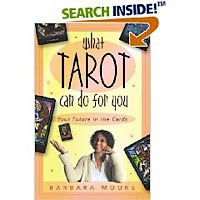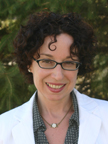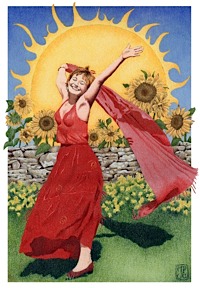By Melanie Harris
Barbara Moore has got it going on. With two new companion books to two new decks premiering this month, she’s as busy and amazing as ever, miraculously still able to find time to get married, go to Italy, make homemade jams, and play in the garden. An acknowledged expert in the world of Tarot, active in the community for years, Barbara has added two new projects to her growing body of work, writing the guidebooks that accompany the Enchanted Oracle and the Mystic Dreamer Tarot, both published by Llewellyn this September. I don’t know how we did it, but we managed to get this jet setting homebody at heart to take time out for an interview, to tell us more about who she is and what she’s doing right now that excites her.
Tarot Reflections: Wow, so you have two projects out this month, guidebooks for the Enchanted Oracle as well as the Mystic Dreamer Tarot. I’m curious about the themes of these two very different decks. Can you tell me more about these latest works?
Barbara Moore: The Enchanted Oracle was a great project to work on. It is different, of course, than a Tarot deck, so it was very new and exciting to me. This kit - it comes with a book, 36 cards, a silver pouch, and a faerie pendant - is full of magic and empowerment. The cards are designed for divination, naturally. But also they and the pendant can be used as magical tools. The book includes pendulum uses, enchantments, journal exercises, visualizations, and prayers. It is meant to help the user find her own power and magic and apply that to her life.
The Mystic Dreamer is a Tarot deck based on the RWS tradition. One major difference is all Christian symbolism has been removed. While this is a traditional deck, it still brought something new to my life. This deck seems to invite personal reflection and intuitive interpretation more than others I’ve worked on. I had to find the balance between providing enough information for a beginner to use the cards and allowing enough space for personal, intuitive interpretations. Also, because I felt I should only include very basic information, I had to question my past practice of including my own opinions about how the cards should be applied in one’s life. I never realized before how much my own ideas of a ‘healthy, balanced life’ came through in my card interpretations. Who am I to tell people what their life should look like? It was a pretty intense realization. Also, I usually provide a spectrum of meanings for the cards, which a user can use as upright or reversed meanings if they wish, but I have never written ‘reversed meanings.’ When I started working on this deck, it told me its reversed meanings before I even started writing. So even though I don’t use reversals, these cards were kind of bossy and insisted. This deck also invited lots of spreads, more than I’ve ever created for a book before. I love creating spreads and so far the initial feedback has been very positive. But you asked about the theme - this deck is really one of personal exploration. There is a foundation, to be sure, but it is just a starting off point. It is designed to enhance self-reflection and discovery.
TR: Did you work on the books for both the Mystic Dreamer and the Enchanted Oracle simultaneously?
B: No, I wrote Enchanted first, then Mystic Dreamer.
TR: I understand these decks are by different artists, Jessica Galbreth illustrating the Enchanted Oracle, and Heidi Darras designing the Mystic Dreamer. Did you collaborate with the artists when you wrote the accompanying texts, or did you work independently?
B: For Enchanted, I worked mostly independently but kept in contact with Jessica when I needed information about symbols she used that I wasn’t clear about. And, as with all my books, the artist does get to see it before I turn it in for publication. Jessica was very pleased.
For the Mystic Dreamer, I did have artist’s notes from Heidi. I incorporated her thoughts and ideas as much as possible.
TR: How did you first start working with the Tarot? How did you learn to read the cards?
B: During my junior year of college, I shared a townhouse with another non-trad student. We had parties fairly frequently. We hung with the SCA crowd. At one of the parties, the talk turned to fortune telling and such. My roommate brought out a small wooden box with a deck of cards in it. I believe it was a RWS deck. Everyone took turns trying to read with them, including me. All we had was the LWB. No one really knew anything. But I was curious…and hooked.
TR: So, once your interest was sparked, how did you learn to read the cards?
B: People learn differently. My preferred way of learning is to get a handful of books, read them all, and figure things out. I believe I started with Step-by-Step Tarot by Terry Donaldson and Tarot in Ten Minutes by Richard Kaser. These were quickly followed by The Tarot: History, Mystery, and Lore by Cynthia Giles. I cannot remember for sure, but I think that is the book with a Major Arcana only spread that is the only one I used for a long time. My first deck was the Haindl Tarot. That kind of amazes me, because there is no way I’d be able to read with it now. I think that using just the Majors made it possible at all. Or maybe it was just the perfect deck for me at that time. Anyhow, I just kept reading and learning more and playing with the cards with my friends and one of my sisters. Eventually, I found the ATA, studied for certification, and then ended up at Llewellyn where I had the opportunity to really get involved with the community.
TR: Oh, yeah, you served as Llewellyn's Tarot specialist for a while, didn’t you? Tell me how you landed that gig, and what that job entailed.
B: I started at Llewellyn as a production assistant, then transferred to the acquisitions department as the new submissions editor (glorified assistant and person in charge of the slush pile). As my interests and experience grew, I proposed changes in my job until it finally transformed into ‘Tarot Specialist.’ Really, that meant I was the Acquisitions Editor responsible for Tarot. So, I acquired, of course. I worked on some developmental editing, but there was always a production editor who did the real work. Other duties included project managing each project from acquisitions through production, negotiating contracts, communicating with the author and/or artist, serving on launch and cover committees, reviewing catalog and back cover copy, presenting titles at the sales conferences, reviewing sales numbers and making informed choices based on those numbers, doing whatever writing assignments came my way, such as for the e-newsletter and New Worlds magazine. Oh, and probably the most fun part: I went to conferences.
TR: That sounds incredibly busy, and exciting. I wonder how you got there exactly. What was your first ever experience with the world of publishing?
B: In third grade, I was the editor of our elementary school newspaper, the Schwartzkoff Cougar Comments. After that, I was out of publishing until college. I was an editor of our literary magazine. Then I ended up as assistant editor for an academic journal (the Michigan Historical Review). Later, I worked for Henry Ford Museum and Greenfield Village where I was the editor of two internal publications. And finally, I joined Llewellyn, which was my first experience with book publishing.


